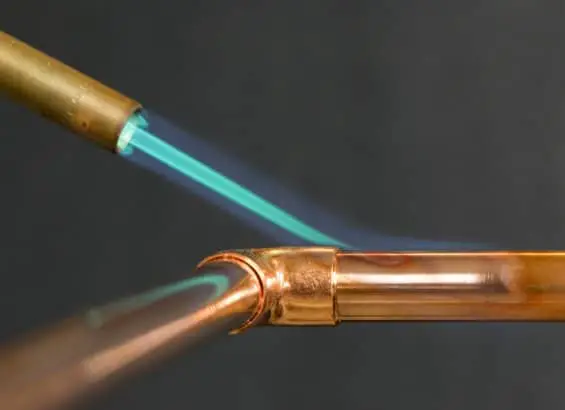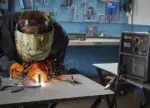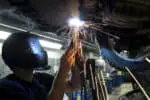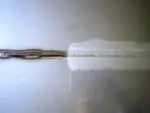You can weld brass with silicon bronze, phosphor bronze and aluminium bronze electrodes!

Both bass and bronze are alloys of copper with just the difference of presence of zinc and tin in them, wherein the concentration of copper is in majority in both. Therefore, the melting temperatures of both the metals that is brass and bronze is quite high; approximately nearly 1700 degrees F.
Stronger Oxidising flame is the best for welding brass and bronze because this flame type produces the high heat needed to weld the two metals together which is around 6300 degrees F.
This article will help you learn the various facts regarding the welding of bass and bronze: the methods to weld both the metals and the types of flames that should be used to weld both!
So, let’s delve deep…
Can you weld bronze to brass?
Bronze is an alloy of copper and tin while brass is an alloy of copper and zinc.
So, you see both brass and bronze have copper in it and therefore the melting points of both bronze and brass is almost same and that is around 1600 degrees F to 1800 degrees F.
Therefore, you can easily weld brass and bronze with a number of processes which I am going to discuss below:
Welding brass and bronze using metal arc welding technique
This is the most successful method to weld brass and bronze.
Requirements:
-
-
- Electrode positive has to be used
- The electrode should be of the shielded arc type
- You need to use backing plates that matches the metal or copper
- You should not use high welding current as this will volatize the zinc content in the metals
- The entire welding has to be carried out in the flat position
- The weld metal has to be deposited with a wave that is 3 times the width of the electrode
-
Welding brass and bronze using carbon arc welding technique
This technique is used to weld brasses and bronze with filler rods that have almost the same composition as the base metals.
Requirements:
-
-
- The metal in eh carbon needs to be super-heated
- The hot metal is then alloyed to the base metal in the joints
-
Welding brass and bronze using oxyacetylene welding technique
This technique is used to weld low brasses.
Requirements:
-
-
- Silicon copper welding rods are preferable
- For high brasses, low-fume welding rods are advisable
- You will require a flux
- You need to adjust the torch flame to slightly oxidizing flame in order to control the fumes
- You might require an auxiliary heat source
- Pre-heated is desirable
-
Welding brass and bronze using gas metal arc welding technique
This technique is used to join large phosphor bronze fabrications.
Requirements:
-
-
- The travel speed has to be kept high
- The weld pool has to be kept small
- Direct current has to be used along with electrode positive
- You need to use stringer beads
- Hot peening of each layer of the metal is necessary to reduce chances of cracking and to reduce welding stress
-
Welding brass and bronze using gas tungsten arc welding technique
This technique is used to join phosphor bronze sheets.
Requirements:
-
-
- Hot peening of each layer of the weld metal is essential
- You need to use direct current, electrode negative
- Helium or argon shielding gas is required to be used
- Pre-heat the metal to 350 to 400 degrees F
- Increase the travel speed to the max
-
Welding brass and bronze using shielded metal arc welding technique
This welding technique is used to join bronzes of similar composition.
Requirements:
-
-
- You will need phosphor bronze covered electrodes
- You have to use direct current and electrode positive
- To get the best of weld joint mechanical properties, the filler metal should be deposited as stringer beads
- To reduce moisture, bake the electrodes at 250 to 300 degrees F
-
Which flame is used to weld brass and bronze?
The melting temperature of bronze is 1620 degrees F to 1680 degrees F and that of brass is 1700 degrees F to 1800 degrees F.
A propane torch with an oxidizing flame produces temperature around 3600 F degrees and an oxyacetylene torch with an oxidizing flame produces temperature around 6300 degrees F.
Therefore, oxidizing flame is perfect for welding brass and bronze together!
Oxidizing flame is best for welding brass and bronze because both have copper in it and copper is oxygen free and oxidizing flame have excess of oxygen in it. Also, oxidizing flame produces the highest heat which is required in the welding of both brass and bronze.
See also: What type of flame to use to weld aluminium?
And it’s the End!
Brass and bronze are very easy to weld due to their similar composition and similar melting points and as you have learnt there are a number of ways to weld the two of them.
The selection of the process will only differ with the percentage of zinc in the metal!
Hope you enjoyed reading the article. Stay tuned for more information and tips on welding!
Hope you have a great day ahead!






